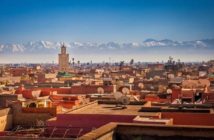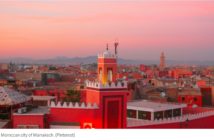By Myrisa Luke

The ramparts at Taroudant. (Myrisa Luke)
Elsewhere, trees full of goats are not an everyday sight. But then, “Morocco is a place where everything is possible and nothing is certain”, as my Moroccan friend Faical likes to say, borrowing a phrase from Richard Branson’s sister, Vanessa. She knows the country well.
The minibus driver taking us across the Sousse Plain to the Atlantic coast shakes his head when asked to stop and pulls over by a road sign saying “40 kilometres to Agadir”. “Why?” he asks. “They want to take photos of goats? Not of people?”
In the upper branches of the argan trees by the roadside, goats sit merrily munching the fruit. The rest of the herd stand upright on their hind legs, feeding from the lower branches. We are within a 10,000 square mile UNESCO Biosphere Reserve, in the argan tree’s natural habitat.
The edible and cosmetic oils produced from the kernels are sometimes called “liquid gold”. The cosmetic variety is now a sought-after ingredient for skin and hair products, because its high concentrations of vitamins A and essential fatty acids help to beautify skin and hair. Perhaps this explains the herd’s lustrous coats
Old Kasbah, New City
Our small group is taking a relaxing short break in the resort of Agadir. The flight time from London is three hours. The weather is mild and sunny, with more than 300 days of sunshine each year.
High on a hill, in the old walled city or Kasbah, you get a 360-degree view of the distant Atlas Mountains, three ports, the city, and Agadir Bay’s five-and-a-half-mile yellow, sandy beach.
A camel standing outside the old Kasbah walls. (Myrisa Luke)
Now, it is calm and peaceful, but, Abdullah our guide says, “Once an earthquake demolished everything except the Kasbah walls. A third of the population, 15,000 people, died on that February night in 1960. Only three buildings survived – on the High Street, right at the bottom of the hill, by the seaside.”
He adds, “Since the earthquake, the structure of the society has changed. There’s quite a strong middle class now.”
The words “God, Country and King” written in Arabic on the hillside can be seen from the new city that was built to the south, where many buildings are painted white, orange trees are heavy with fruit, and jacaranda purple flowers bloom.
It is 11 a.m. on a market day at the souk. Outside, cooking utensils are displayed here while colourful underwear is piled up over there. Inside, a turkey fusses, parakeets perch quietly in cages like inanimate little toys, and pomegranates the size of grapefruits add to a kaleidoscope of colours on fruit and vegetable stalls.
By the Sea
Agadir has a wide range of hotels. We are staying at The Sofitel Agadir Royal Bay Resort in Palm Bay. The luxury hotel’s main doors open into a spacious lobby, with large potted palms and comfortable sofas. The sliding glazed roof is open to the skies during the day for alfresco relaxation. At night the roof is closed and the lobby comes alive with coloured lights and live music.
Fishermen selling their catch at sea. (Myrisa Luke)
In the rear gardens, terraces and pools lead down to the wide sandy beach. Guests come to sit by the shore in the evening to listen to the rhythm of the waves and watch the sun dip below the horizon.
On the first evening we meet for pre-dinner drinks by the pool bar, sipping mojitos and Laurent-Perrier champagne beside flames leaping out of a cascading fountain, and sampling irresistible canapés such as spring rolls, salmon sushi, and chocolate profiteroles.
Later, we have dinner at 33 Yacht Adress, a newly-opened restaurant in Agadir Marina. The view from our table is of a large, well-lit public space, with people out strolling and enjoying the evening breeze. My attention switches to my plate as soon as my expertly grilled sole is served.
We return to the marina one morning for an Atlantic excursion. “Do you have a king who can jet ski?” we are asked as we step on board the yacht Federika. A photograph of King Mohamed VI, skimming the waves, is passed round with pride. As we cruise along the coast, a big parasol appears in the sea, tossed about by the waves. When we get closer, it turns out to be a giant jellyfish.
The yacht anchors in a protected cove: “A good spot for catching mackerel” according to the crew. Although I am not lucky, others reel in their silvery catch while the crew prepare our lunch of freshly grilled fish with salad.
To Taroudant
Agadir is a good base for going trekking in the Atlas or for exploring the coast and other towns in the region. This is an agricultural area. On the way to Taroudant we drive past a farm where a family is out harvesting potatoes, and find ourselves behind a truck loaded with sheep.
Women extracting argan oil in Taroudant. (Myrisa Luke)
Taroudant is sometimes called “the little Marrakesh” – it is smaller, quieter, and much more laid-back. From the ramparts, there is a view of a palm-tree-lined avenue running outside the ochre Kasbah walls, with the Atlas Mountains in the distance.
The lively main square near the souk, where men sit chatting on low walls built around the bases of shady trees, is full of character. From here it is a short walk to the Roudana Targanet Argan Oil Co-operative where visitors can see the precious oil being produced.
Afterwards, we lunch at the La Gazelle d’Or, an exclusive luxury hotel nearby, set in acres of organic farms, orchards, and gardens of earthly delight, where we are spoilt for choice at the buffet table on the terrace.
During lunch we spot a famous French actress in the pool; however, the privacy of the guests who stay here, including VIPs and celebrities, is regarded as highly important.
The owner, Rita Beniss, tells us how she fell in love with the place, then decided to buy it. She takes us down a scented walk lined with white roses, through more gardens with tweeting birds, to show us the inviting stone villas with open fireplaces. “And here is the hammam,” she says finally, opening an intricately carved door into a fragrant haven dedicated to repose and well-being.
Final Pleasures
A stall selling olives in Agadir Souk. (Myrisa Luke)
On our last evening in Agadir, we dine in the restaurant of Riad Villa Blanche, a deluxe boutique hotel. Soft lights reflect off the floor tiles and tied-back drapes cocoon the space. I order some Moroccan wine and a quintessential Moroccan dish – chicken tajine with piquant preserved lemon and subtly blended spices.
We took a tour of the hotel after dinner, admiring the design and objets d’art, while imagining ourselves taking a dip in the pool or relaxing in the spa.
Related Articles
Mazatlan, Mexico: Pearl of the Pacific
The pleasures of a spa session are reserved for the final morning back at our hotel. Expert hands begin a relaxing massage with a blend of argan oil and aromatic essences. It starts to work its magic; I close my eyes and think of argan-loving goats in trees.
How to get there
British Airways operates a twice weekly service to Agadir from London Heathrow.
Where to stay
The writer stayed at Hotel Sofitel Agadir Royal Bay Resorts
www.sofitel.com
Riad Villa Blanche
www.riadvillablanche.com
La Gazelle d’Or Hotel
www.gazelledor.com
Find out more
The Moroccan National Tourist Office
www.visitmorroco.com; www.agadir.travel
The Lonely Planet Guide to Morocco
www.lonelyplanet.com
Myrisa Luke is a travel writer whose features and photographs have been published in the UK, America, Australia, and Canada.
The Epoch Times publishes in 35 countries and in 19 languages. Subscribe to our e-newsletter.






